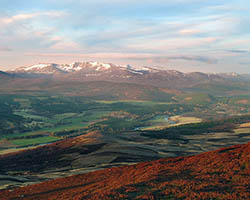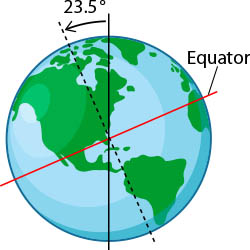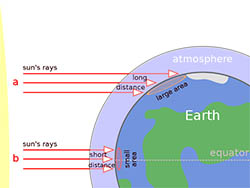
Illustrated by: Sabine Deviche
Why Do We Have Seasons?

It's spring. The frost of winter has slowly melted under the warming skies and the flowers are in full bloom. But spring doesn’t last forever. In a few months, temperatures will soar as summer arrives. Then, the temperature will slowly cool again through autumn before the land chills back down to winter.
Many parts of the world experience seasons as a normal part of life. But why does the Earth have seasons?
A Leaning Earth
Imagine running a pole through the center of the Earth from the most Southern point to the most Northern point. Instead of standing straight up and down, the pole sits at an angle. Every day, the Earth revolves once around this tilted pole, which is also called an axis.

While the Earth rotates around the sun, the tilt of the axis always faces in the same direction. This means that when the Earth is on one side of the sun, the Northern Hemisphere leans toward the sun. During this time, the sun beams more directly on the Northern Hemisphere than on the Southern Hemisphere.
When the Earth is on the other side of the sun, the Southern Hemisphere leans toward the sun and the sun shines more directly on the Southern Hemisphere. Seasons are caused by the amount of direct sunlight that reaches a certain part of the Earth. The amount of direct sunlight changes in most places as our planet revolves around the sun.
Sunny Side Up
Summers can get so hot that you can feel like you're melting. Winters can get so cold that you feel like a human popsicle. Can the tilt of the Earth really be responsible for such extreme changes in the weather? Yes, it can.
First, let's talk about sunlight. Light from the sun is made up of tiny particles called photons. When a stream of photons, or sunlight, travels from the sun to any surface on Earth, it heats up that surface. That's why our skin grows hotter when we stand out under the sun. This is also why the ground heats up when the sun's out.
However, you warm up faster if you stand under the sun during the summer than during the winter. The reason for this has to do with the angle at which sunlight hits the Earth during each season.
Detangle the Angle

Imagine that the sun is a can of spray paint and that the floor is the Earth's surface. If you hold the can directly above the floor and spray down, the drops of paint will land close together. If you put the can of paint on the floor and spray from an angle, the drops of paint will land far apart from each other.
Sunlight that reaches the Earth's surface works in the same way. Think about how your location moves in relation to the sun every day. When the sun is directly overhead, photons land closer together and deliver more heat. This is why it’s so easy to warm up during midday. When the sun is on the horizon, photons land far apart. The spread of those photons delivers less heat to your location, which is why it’s harder to warm up at sunrise and sunset.
Additional images by Wikimedia Commons. Winter mountains by Dmitry A. Mottl.
Read more about: Switching of Seasons
Bibliographic details:
- Article: Switching of Seasons
- Author(s): Sisi Gao
- Publisher: Arizona State University School of Life Sciences Ask A Biologist
- Site name: ASU - Ask A Biologist
- Date published:
- Date accessed:
- Link: https://askabiologist.asu.edu/explore/switching-seasons
APA Style
Sisi Gao. (). Switching of Seasons. ASU - Ask A Biologist. Retrieved from https://askabiologist.asu.edu/explore/switching-seasons
Chicago Manual of Style
Sisi Gao. "Switching of Seasons". ASU - Ask A Biologist. . https://askabiologist.asu.edu/explore/switching-seasons
Sisi Gao. "Switching of Seasons". ASU - Ask A Biologist. . ASU - Ask A Biologist, Web. https://askabiologist.asu.edu/explore/switching-seasons
MLA 2017 Style

Winter in the northern hemisphere starts in December, but in the southern hemisphere, it starts in June.
Explore hands-on why there are seasons with our classroom activity Seasoned to the Tilt.
Be Part of
Ask A Biologist
By volunteering, or simply sending us feedback on the site. Scientists, teachers, writers, illustrators, and translators are all important to the program. If you are interested in helping with the website we have a Volunteers page to get the process started.
